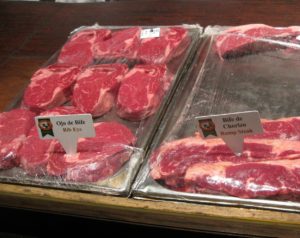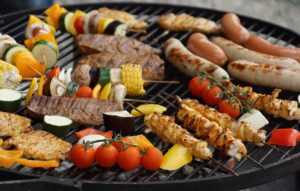 Even though we spend less on food compared to many other countries, our food expenses still make up a big chunk of our monthly budget. The good news is there are simple ways to lower food costs and still eat nutritiously!
Even though we spend less on food compared to many other countries, our food expenses still make up a big chunk of our monthly budget. The good news is there are simple ways to lower food costs and still eat nutritiously!
Question: What’s the most expensive food in your refrigerator?
Answer: Food wasted, thrown out or gone bad because it wasn’t eaten!
- The average U.S. family of four throws away $590 – $1600 worth of food each year. Creating a weekly menu that coordinates with grocery sales and food already on hand is an extremely effective way to save. You will have all needed ingredients and resist the urge to eat out or grab a costly, not-so-nutritious convenience food.
Consider the following food budget tips to save even more:
Check Unit Prices
Get the best deal by comparing unit prices, not just total price.
- Unit price shows cost per ounce, pound, or other amount so you can easily compare food in different sized quantities.
 Look for cheaper cuts of meat
Look for cheaper cuts of meat
Cuts from the shoulder and leg (i.e. chuck, arm, shank) are very flavorful and considered a “value cut” because of cost.
- For more information on selcting the most affordable types and cuts of meat, check on the meatmattersinfo.org website.
- Cheaper cuts can easily be tenderized by marinating, scoring, slow cooking or braising.
- Make your meat go even further by replacing a portion with whole grains, beans, oatmeal or pasta.
Use “planned overs”
Planning to have leftovers can minimize costs and food waste, by enabling you to cook once but enjoy certain dishes and foods more than once.
- Extra roast chicken from dinner can be chicken salad the next day.

Spinach salad made using leftover chicken strips - Cooked ground beef for tacos one night can be in spaghetti sauce the next.
- Create a nutritious soup or casserole with leftover vegetables, rice or pasta.
- Refrigerate “planned overs” in small containers that can easily be packed in lunches–some dishes are actually better the next day!
Look High and Low for Savings
Items and brands stocked at eye level and end-of-aisle displays are often the most expensive.
- Cheaper items are typically on the higher and lower shelves.
Consider Buying Generic Items
Save 15 – 20% on generic or store brand foods. Generally there are very few differences.
Buy Produce in Season
In-season fruits and vegetables can be 10 to 50% less compared to the out-of-season price and they’re usually more delicious and nutritious, too!
- Find when produce is in season where you live at www.fruitsandveggiesmorematters.org/what-fruits-and-vegetables-are-in-season.
- Buy and enjoy produce at peak season. Preserve extra for months when it isn’t in season! Use CSU Extension’s Preserve Smart website/app to find instructions and recipes!
- When foods are not in season, frozen and canned (with little or no added sugar or salt) are great options.

Stockpile Nonperishable and Bulk Food
Stock up on sales for nonperishable items or bulk packaged foods you normally buy.
- Buy larger quantities only if you have storage space and will use it before it spoils.
Read Food Labels
Food labels help compare serving size and nutrients.
- Use the % Daily Value in the Nutrition Facts panel.
- Nutrients at 5% or less are low – aim low in saturated fat, trans fat, cholesterol and sodium.
- 20% or more is high – aim high in fiber, vitamins and minerals.
Healthy Choices Can Be Cheaper
People spend a lot on “extras” – foods with calories but little nutritional value, like sodas, bakery items, and chips.
- Get more bang for your buck by choosing nourishing, wholesome foods.
- Consider price based on number of servings and nutritional value.
- Costs of food choices not only effect your wallet but can also hurt your health, leading to expensive medical bills, costly medications, lost work days, etc.
 Explore more ways to save money and eat healthfully at http://snap.nal.usda.gov/resource-library/handouts-and-web-sites/meal-planning-shopping-and-budgeting
Explore more ways to save money and eat healthfully at http://snap.nal.usda.gov/resource-library/handouts-and-web-sites/meal-planning-shopping-and-budgeting


Great ideas, quality food is such a significant part of my budget! Thanks
Great Blog post for sure….Thanks